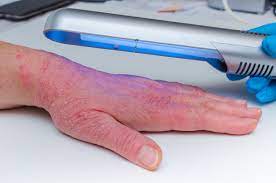Article
Medium-Dose Ultraviolet A1 Cold Light Preferred Atopic Dermatitis Treatment
Author(s):
Though high-dose ultraviolet therapy was also effective, investigators were concerned with the potential long-term adverse events.

An investigation into phototherapy for the treatment of atopic dermatitis found that medium-dose ultraviolet A1 (UVA1) cold light was the superior form of treatment when compared to the long-term adverse effects of high-dose UVA1.
The investigators, led by Hui Xiao, MD, Department of Dermatology, Xiangya Hosptial, China, believed that phototherapies could represent an efficient option for the treatment of atopic dermatitis.
Despite being used for clinical purposes for over 50 years, previous studies had shown contradictory results regarding the effectiveness of different forms of phototherapy for the treatment of atopic disease.
As such, Xiao and colleagues conducted the present study in order to systematically evaluate the clinical efficacy of different forms of phototherapy in the treatment of atopic dermatitis.
The Methods
Xiao initiated the study by conducting a thorough, systematic literature search using PubMed, Embase, and the Cochrane databases from up to April 2021 using relevant keywords.
A review of acceptable literature was prospectively registered in the PROSPERO systematic review registry.
Investigators noted that the search was strictly limited to randomized controlled trials.
Data on participants, interventions, clinical types and outcomes of therapy were obtained from the included studies.
The primary outcomes of the study incorporated clinical signs and symptoms according to predefined criteria including the Scoring Atopic Dermatitis (SCORAD) Score, the Costa score, the Leicester Sign Score, and more.
The main outcome for comparison in network meta-analysis was SCORAD score absolute changes from the baseline. Mean differences and standard deviations were estimated if a study did not report SCORAD absolute scores.
Overall, a total of 55 articles were included in the study, with a total of 631 combined patients.
The Findings
According to the articles included in the study, the results indicated that narrowband ultraviolet B (NB-UVB) and UVA1 therapy were the superior therapeutic choices for patients with atopic dermatitis.
Some forms of UVA1 therapy, such as HD-UVA1, had markedly reduced the Costa score in participants of various studies compared to UVA-UVB.
However, another study reported that NB-UVB was significantly better for the improvement of disease activity as opposed to other phototherapies.
Xiao and colleagues included data from another study which showed that both UVA and UVB resulted in significant reductions in SCORAD scores from baseline to 12 weeks of treatment, with the UVB group showing a 53% reduction while the UVA group showed a 93% reduction.
Overall, the most effective treatment recorded in the study was HD-UVA1, followed by MD-UVA1 cold light, though investigators noted that HD-UVA1 was not significantly superior.
To their knowledge, Xiao and colleagues conducted the first systematic review and meta-analysis that comprehensively assembled evidence from RCTs for different modalities of phototherapy for the treatment of atopic dermatitis.
Despite the effectiveness of HD-UVA1, investigators reported that it had more cumulative radiation exposure, which could cause less patient acceptability and the possibility of long-term adverse effects such as photoaging and carcinogenic potential.
“MD-UVA1 cold light therapy is a safe and well-tolerable treatment, it includes a cooling system that can filter the infrared radiation and decreases the heat emission , and it is an well-tolerated treatment modality that avoids some side effects such as feeling of massive heat, transient erythema, and potentially pro-inflammatory sweat secretion,” the team wrote. “Therefore, we recommend the MD-UVA1 cold light represents an optimal resource of UVA1 therapy for the treatment of AD.”
The study, “Phototherapy for atopic dermatitis: systematic review and network meta-analysis of randomized controlled trials,” was published online in Photodermatology, Photoimmunology, and Photomedicine.





